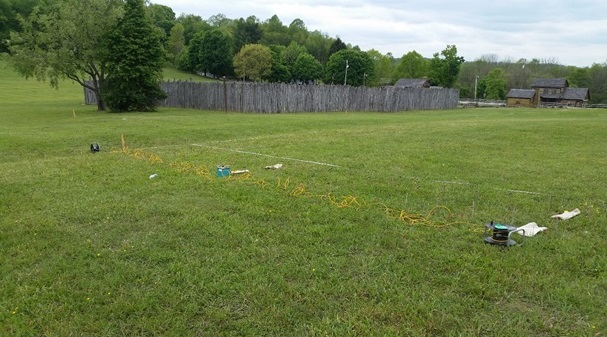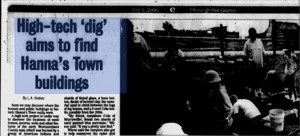By David Breitkreutz
This summer I’ve been mostly keeping up with my thesis research – a spatial analysis of Hanna’s Town using geophysics. The IDS Multi-Array Stream X ground penetrating radar, the FM 256 Fluxgate Gradiometer, and the Syscal Kid electrical resistivity meter were employed to help determine the layout of the settlement, potentially locate evidence of the 1782 raid, and to determine the extent to which geophysical applications are useful in surveying large archaeological sites. The past few weeks I’ve been employed, with TRC, on a historic Phase II near Cumberland, Maryland. After work I’ve been analyzing the results of my geophysical investigations and actually writing the thesis.
While conducting background research, on previous archaeological and geophysical investigations at Hanna’s Town, I reminded myself that I worked at Hanna’s Town in the summer of 2000, while employed with Christine Davis Consultants, Inc. out of Verona, Pennsylvania. Enviroscan Inc. was sub-contracted to conduct geophysical investigations using magnetometers and ground-penetrating radar. This was the first geophysical investigation conducted at Hanna’s Town. Also, the project was my introduction to geophysical techniques and public archaeology.
That summer the Westmoreland County Historical Society sponsored their first archaeology day camp for children and teenagers, between the ages of 11-15. The students were treated to demonstrations by re-enactors, they screened dirt from our excavations, a few were allowed to “play” with the GPR, and the students were given field trips to Bushy Run. The most rewarding aspect of the project was teaching the students that had a genuine interest in archaeology. The most frustrating thing for me was debating, with the chaperons, why it’s unproductive to have the students collect cigarette butts at a Colonial site.
Over the course of the next sixteen years I became less condescending towards volunteers, avocationalists, students, and supervisors. I had learned that interest in archaeology can greatly aid in site preservation. Public archaeology/history can also generate a pride in local history. During my resistivity survey, earlier this summer, a WCHS volunteer re-enactor approached me asking me “can I help you.” I jokingly informed him that his help will be “greatly appreciated” and that I needed the “electrodes placed in 50cm intervals.” In the end he really didn’t want to help and only wanted to know if I had permission to be on the property. The re-enactor was there to guide students, from local elementary schools, around the site. There was at least six bus-loads of children per day at the site during the early summer days. It was great to see these field trips.
While researching the Davis project I found an article from the Pittsburgh Post-Gazette, dated July 5 2000, titled High-tech ‘dig’ aims to find Hanna’s Town buildings . Unfortunately, the pictures from the newspaper article were too black to distinguish a younger and thinner Dave. Nonetheless I was seized with a sense of nostalgia. The “trip down memory lane” made me realize (or fear) that my entire career in archaeology has come full circle. Sixteen years later I am working on the same site, arguing with the same volunteers, while asking the same research questions using geophysical techniques. Within the article former WCHS Director James Steeley stated that the goal of the project was to locate where the houses and buildings “really were.” This is exactly the same research objectives as my thesis. In fact this dilemma has stifled all archaeologists that have conducted research at Hanna’s Town. The biggest lesson I learned here is that the results, and methods used, from an archaeological or geophysical investigation may not answer the research objectives set forth. Even if the research objectives weren’t accomplished it is still important to interpret the results from the data collected. I won’t divulge my preliminary results from my thesis research. But I will say that I keep on telling myself “a good thesis is a completed thesis”.


